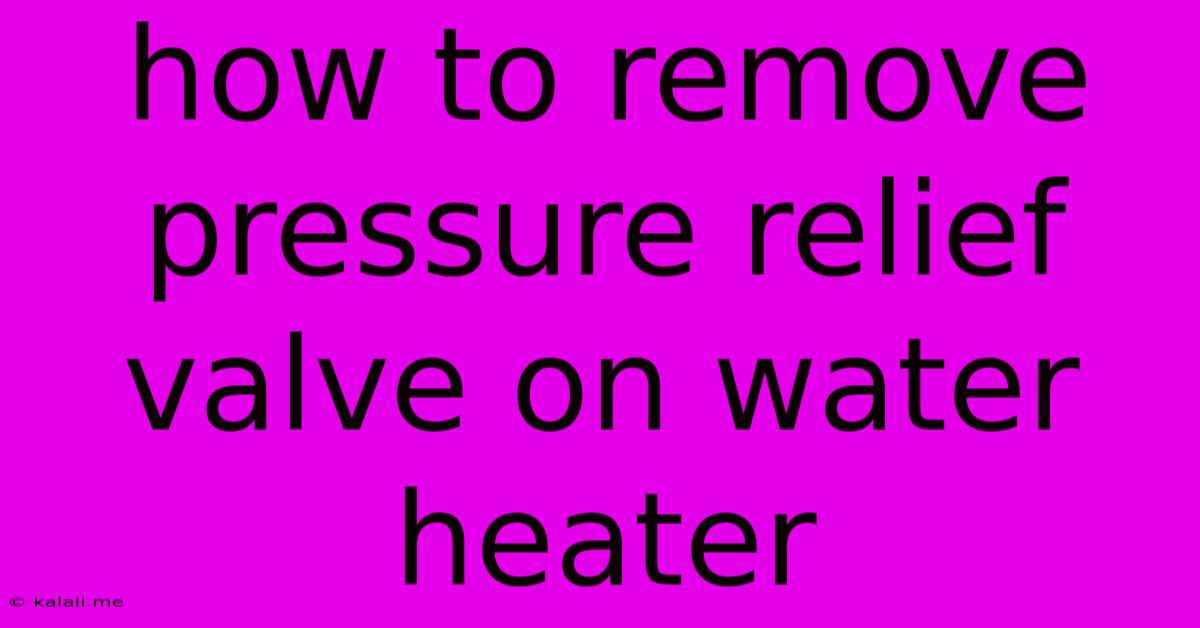How To Remove Pressure Relief Valve On Water Heater
Kalali
Jun 05, 2025 · 4 min read

Table of Contents
How to Remove a Pressure Relief Valve on a Water Heater: A Step-by-Step Guide
This article provides a comprehensive guide on how to safely remove a pressure relief valve (PRV) from your water heater. A malfunctioning PRV can lead to serious issues, so knowing how to replace it is crucial for maintaining the safety and efficiency of your water heating system. Always prioritize safety and, if unsure about any step, consult a qualified plumber. This guide is for informational purposes only and does not replace professional advice.
Understanding the Pressure Relief Valve
The pressure relief valve (also known as a temperature and pressure relief valve or T&P valve) is a crucial safety device on your water heater. It's designed to release excess pressure and prevent potentially dangerous situations like tank explosions. Understanding its function is critical before attempting any removal or replacement. The valve is usually located near the top of the water heater tank. It's typically a small, vertical valve with a lever.
Tools You'll Need
Before you begin, gather the necessary tools:
- Adjustable Wrench: To loosen and tighten the valve.
- Bucket or Pan: To catch any remaining water inside the valve.
- Shop Towels or Rags: For cleaning up spills.
- New Pressure Relief Valve: (It’s crucial to replace the old valve with a new one of the same type and pressure rating.)
- Optional: Pipe Wrench: For added grip, especially if the valve is stubborn.
Step-by-Step Guide to Removing the Pressure Relief Valve
1. Turn Off the Water Heater: Locate the shut-off valve for the cold water supply line to the water heater. Turn it clockwise to completely shut off the water flow.
2. Allow the Water Heater to Cool: Allow the water heater to cool completely before proceeding. Hot water can cause serious burns.
3. Prepare for Water Drainage: Place a bucket or pan beneath the pressure relief valve to catch any residual water that may leak out during removal.
4. Loosen the Valve: Use an adjustable wrench to carefully loosen the valve. Turn it counterclockwise. It might be tight, so use firm but controlled pressure. If it's extremely difficult to turn, consider using a pipe wrench for extra grip. Be careful not to damage the valve body or the surrounding pipe.
5. Remove the Valve: Once loosened, carefully remove the valve by hand. Water may leak out, so keep the bucket underneath.
6. Inspect the Connection: Once the valve is removed, inspect the pipe connection for any damage or corrosion. If you see any issues, address them before installing the new valve.
7. Install the New Pressure Relief Valve: Carefully screw the new pressure relief valve onto the pipe connection. Tighten it securely using the adjustable wrench.
8. Test the New Valve: Turn the cold water supply back on. Check for leaks around the new valve. Manually lift the lever on the new pressure relief valve to verify that it functions correctly. Water should flow out and then stop when the lever is released.
9. Clean Up: Clean up any spills or water mess.
Safety Precautions
- Always turn off the power to the water heater before starting any work. This is particularly crucial if you’re working with electrical water heaters.
- Work slowly and carefully. Avoid using excessive force that might damage the valve or the surrounding pipes.
- Wear appropriate safety gear. Safety glasses and gloves are recommended.
- If you encounter any significant difficulty, consult a qualified plumber. Improper handling can lead to water damage or other issues.
When to Replace Your Pressure Relief Valve
Replacing your pressure relief valve is essential when:
- The valve is leaking: A persistent leak indicates a faulty valve that needs immediate replacement.
- The valve is old or worn: Over time, valves can deteriorate and fail. Regular inspection and replacement are recommended.
- The valve fails to release pressure: If you notice a buildup of pressure in the water heater system, the valve might be malfunctioning.
- You notice any signs of damage or corrosion: Visible damage to the valve is a clear indication that it needs replacing.
Regular maintenance and prompt replacement of a faulty pressure relief valve are key to ensuring the safe and efficient operation of your water heater. Remember, safety is paramount – if you're uncomfortable performing this task yourself, it's best to contact a qualified plumber.
Latest Posts
Latest Posts
-
Band Pass Filter Transfer Function In S Domain
Jun 07, 2025
-
Low Water Pressure In House With Well
Jun 07, 2025
-
Blender Failed To Find Solution For One Or More Bones
Jun 07, 2025
-
Where Is The Blender Tmp Folder In Mac
Jun 07, 2025
-
Google Sheets If Blank Then 0
Jun 07, 2025
Related Post
Thank you for visiting our website which covers about How To Remove Pressure Relief Valve On Water Heater . We hope the information provided has been useful to you. Feel free to contact us if you have any questions or need further assistance. See you next time and don't miss to bookmark.